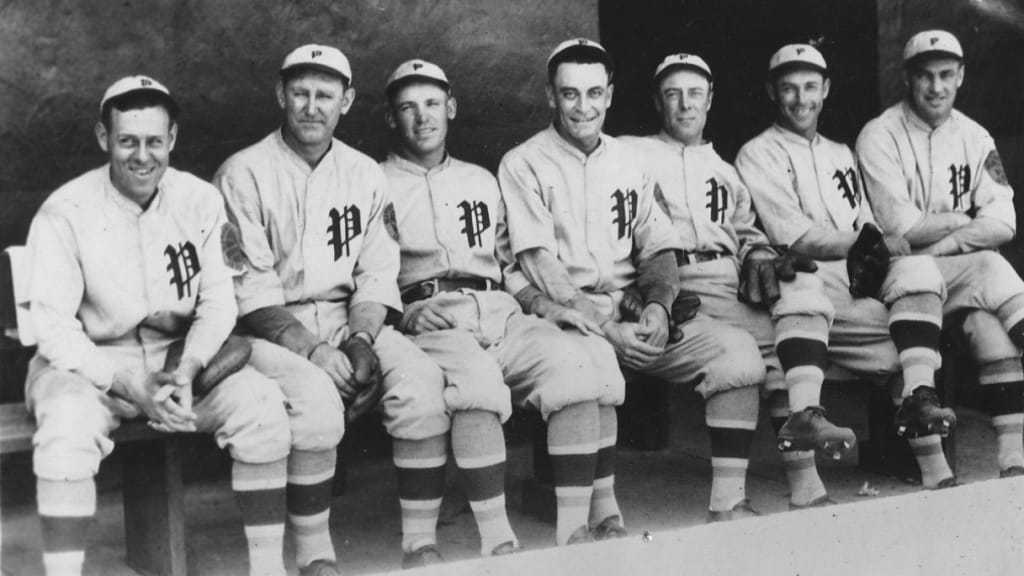
¡°Harper dominates Phillies hitters.¡±
That could have well been the Phillies headline about the 1925 season, the lone highlight. The 5-foot-8, 33-year-old left-handed-hitting outfielder was George, not Bryce. Distant relative? Not hardly. (George is second from right in the photo above.)
How did that Harper dominate? He led the club in runs (86), hits (173), doubles (35), home runs (18), RBIs (97), stolen bases (10), slugging (.558) and average (.349). That lofty average was good enough to finish sixth in the National League. Oh, his 3.5 bWAR was also tops for the Phils. Please understand WAR didn¡¯t exist back then. Somehow, someone took his numbers and calculated a WAR figure. Whatever.
Among Harper¡¯s teammates were 1B Chicken Hawks (serious); SS Heinie Sand; C Jimmie Wilson, a Philadelphia native; 37-year-old OF slugger Cy Williams; CF George Burns (not to be confused with the entertainer); RHP Jimmy Ring, who rang up a club-high 14 wins (16 losses) and a league-high 325 hits and 119 walks; RHP Huck Betts from Millsboro, Del.; and RHP Jack Knight, who had a winning record (7-6).
Knight would become the first Phillies pitcher to hit two home runs in a game the following season, tops for that season¡¯s highlight reel.
Now the bad news
The Phillies finished sixth (68-85) in the eight-team NL and drew 304,905, the league¡¯s smallest. The 1920-29 years were losing seasons, including five with 100 or more losses. It is the worst decade in franchise history. It can be said, the ballclub never recovered from that dastardly decade.
Digging further, the Phillies had a winning season in 1917 (87-65), two years after their first pennant. Their next winning season was 78-76 in 1932. Oh, owner William Baker traded future Hall of Fame pitcher Grover Cleveland Alexander following the 1917 season, his third straight of 30-plus wins. In the deal, the Cubs included $50,000.
The era was billed as the ¡°Roaring Twenties.¡± Apparently not for the Phillies.
Now the good news
The only way to learn how the team was doing was to read a newspaper. Philadelphia, at the time, had something like five newspapers.
Games were not broadcast on radio (the Phillies' first broadcast was 1936). No talk radio, television, cellphones, Internet, social media, podcasts, pitch counts, pitch clocks, armor for hitters and bullpen specialists. Just one man as the manager (Art Fletcher) and one coach (Benny Meyer).
Meyer, 40, pinch-hit in one September game (a 14-4 loss), a double. His career ended with a 1.000 batting average! Several sources claim his nickname was ¡°Earache¡± because he would yell a lot with a piercing voice.
Travel by train, roommates on the road, one set of uniforms, small gloves. No night games, uniform numbers, All-Star Games, MVP Awards, players' union, torpedo bats from Amazon. Here¡¯s a tasty "phun phact": Tastykakes were 11 years old. (Probably larger than today¡¯s).
The season began with an April 14, 3-1 loss in Brooklyn against a team called the Robins (Dodgers). That club¡¯s Spring Training facility was at Athletic Field in Clearwater, Fla., while the Phillies were in Bradenton, Fla.
The season¡¯s longest winning streak was five games, the final five! Game 153 was 3-0, completing a Saturday afternoon doubleheader sweep at Baker Bowl against the New York Giants. Harper had a two-run, two-out double in the third inning. Sand had an error, No. 60!
The leadoff hitters were 3B Heinie Groh (Giants) and SS Heinie Sand (Phillies). A perfect note for Jayson Stark¡¯s weekly ¡°Weird and Wild¡± column.
The season-ending hot streak carried over to 1926, a 3-0 start that led to a worse season, 58-93-1 and last place. The good news, Sand¡¯s errors dropped to 55.
Cost of Living
Visiting with Yahoo: Shoppers paid 47 cents for a pound of bacon, 9 cents for a pound of bread, 55 cents for a pound of butter and 52 cents for a pound of coffee. ... Ford dropped its prices on the new Runabout to $265, a new Chevrolet cost $525 and the luxury Buick Marquette sold for a hefty $965. At the same time, the ultra-luxury Hudson cost $1,795. ... A new electric washing machine, $81.95, and a vacuum cleaner complete with a motor-driven brush, $28.95. A waffle iron, $8.95; electric toaster, about $1.50. ... A new house cost approximately $11,600.
The Philadelphia Daily News was launched. The Philadelphia Inquirer moved into its longtime location at Broad and Callowhill Streets, costing $10 million. ... Chesterfield Cigarettes began marketing to women, and Hormel introduced its first processed meat in a can, which would later be called ¡°Spam.¡±
Spam today can be in a refrigerator, emails, cellphones and old-fashioned mail. The new ¡°Roaring Twenties.¡±